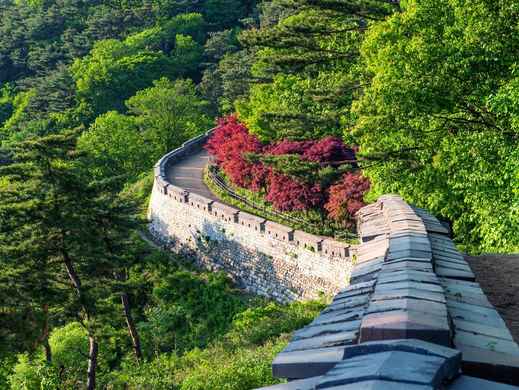


Jeju Island
Asia
/
South Korea
/
Jeju Island
Perched like a volcanic gem in the Korea Strait, Jeju Island is the largest island in South Korea. The island, known for its subtropical climate, is cloaked by Hallasan Mountain and experiences mild winters and warm summers with intermittent rainfall all year round. Scattered across the island are unique ecosystems formed by lava tubes, waterfalls, and striking coastal structures.
A significant distinction of the island lies in its culture, which greatly differs from mainland Korea. This is primarily because of its matriarchal society and the fascinating haenyeo - female divers who have harvested seafood for generations. These women, most of whom are now in their 60s and 70s, represent a dying way of life that has been commemorated by UNESCO.
The charm of Jeju Island lies in the blend of natural wonders and cultural heritage it offers. The tourist hotspot is home to three UNESCO World Heritage sites: Hallasan Mountain, the Geomunoreum lava tube system, and Seongsan Ilchulbong, an impressive tuff cone created by a volcanic eruption. As for local cuisine, it revolves around fresh seafood, black pork (a regional speciality), and unique ingredients such as hallabong citrus.
Remember to pencil in a hike to Hallasan, the tallest peak in South Korea, where you can experience crater lakes and breathtaking views. The Olle Trail system, which includes 26 routes circling the island, is perfect for exploring coastal villages and hidden beaches. To immerse yourself in the island's unique architecture and customs, a visit to the Jeju Folk Village is highly recommended.

Get to Know Jeju Island
Take a tour of this destination's highlights
Popular Areas in Jeju Island

Travel Tips for Jeju Island
What you need to know before traveling here
Getting Around Jeju Island
A guide to Jeju Island's local transportation
Major attractions and cities in Jeju are connected by an extensive bus network. T-money cards, available at convenience stores, serve as the most convenient payment mode. There are express buses plying between Jeju City and Seogwipo. For real-time schedules in English, download the Jeju Bus Information app.
Practical Tips for Jeju Island
Things to prepare and best way to visit
Choose Jeju City for convenient airport access and nightlife, or stay in Seogwipo for a serene atmosphere near natural attractions. Organize your accommodation close to your activities as the island's size might surprise you.
You would need at least 3-4 days to explore major attractions, but ideally, spending 5-7 days will enable you to thoroughly delve into the island and experience its local culture without rush.
English comprehension is limited outside major tourist spots. Therefore, downloading translation apps and learning basic Korean phrases will prove beneficial. Most major attractions do have English signs.
The most favorable times to visit are during April-May for spring blooms and pleasant weather or September-October to witness fall colors and festivals. Summer, from June-August, is peak season but can be hot and crowded.
Though credit cards are readily accepted, it’s wise to carry some cash for local markets, small eateries, and taxi fares. ATMs approving international cards can be found at convenience stores.
See All Practical Tips for Jeju Island

Explore Jeju Island
Create your itinerary with our top picks below

Get to Know Jeju Island

Travel Tips for Jeju Island

Explore Jeju Island








![[Jeju] Bicheollin Theme Park, 450.733 VND](https://ik.imagekit.io/tvlk/xpe-asset/AyJ40ZAo1DOyPyKLZ9c3RGQHTP2oT4ZXW+QmPVVkFQiXFSv42UaHGzSmaSzQ8DO5QIbWPZuF+VkYVRk6gh-Vg4ECbfuQRQ4pHjWJ5Rmbtkk=/7930833000876/-Jeju-Bicheollin-Theme-Park-88297d28-d5db-4bb7-a4d3-e2027b0fc02f.jpeg?_src=imagekit&tr=c-at_max,h-456,q-60,w-256)








![Aqua Planet Jeju Aquarium Tickets [Foreigners Only], 549.645 VND](https://ik.imagekit.io/tvlk/xpe-asset/AyJ40ZAo1DOyPyKLZ9c3RGQHTP2oT4ZXW+QmPVVkFQiXFSv42UaHGzSmaSzQ8DO5QIbWPZuF+VkYVRk6gh-Vg4ECbfuQRQ4pHjWJ5Rmbtkk=/1001316834588/Aqua-Planet-Jeju-Aquarium-cefec5fe-3b8d-49e2-ae35-9e22706f8b74.jpeg?_src=imagekit&tr=c-at_max,h-456,q-60,w-256)













 Facebook
Facebook Instagram
Instagram TikTok
TikTok Youtube
Youtube Telegram
Telegram
